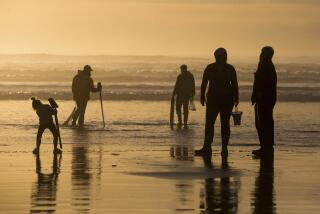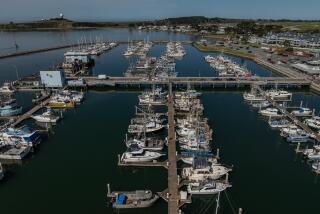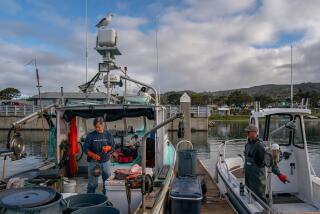Clammers, an Independent Lot, Are at Red Tideâs Mercy
FREEPORT, Maine â Every day this time of year, Vicki Cisco and Herbert Moon leave home at dawn and take their 14-foot aluminum skiff to a nearby tidal flat. Starting when the tide is lowest, they squat in the mud for six hours, digging for clams with gloved hands and pitchforks adapted to serve as hoes.
In a normal season, the couple bring in $300 to $400 a day, enough to see them through the harsh winter months. But a red tide that is now in its seventh week has put a stop to clamming on two-thirds of Maineâs coastline.
Cisco and Moon are two months behind on their mortgage. They have borrowed money from relatives and made fruitless appeals for help to state and local agencies.
âThis is killing us,â Cisco said. âIf we donât lose this house, it will be a miracle.â
Maine officials say the influx of toxic algae is taking at least a $2-million bite every week out of the stateâs shellfish industry, which brings in $20 million per year. Clamming is a year-round enterprise, but demand is heaviest in late spring and summer.
This is the most severe red tide in decades, prompting Gov. John E. Baldacci to declare an economic emergency for the shellfish industry.
Scientists say the huge bloom of an algae species called Alexandrium fundyense has produced some of the highest levels of toxicity in shellfish in more than 30 years.
According to marine experts, the algae could start dissipating as early as next week. But for those whose incomes depend on the four- to five-month-long shellfish season, the losses could be long-term.
âIn a coastal economy that doesnât have a lot of other alternatives, this is a very prolonged disaster,â said Deirdre Gilbert, assistant to the director of the state Department of Marine Resources.
The red tide is caused by a single-cell phytoplankton that in masses gives the ocean a rosy hue, said David Townsend, chairman of the School of Marine Sciences at the University of Maine.
High concentrations of this algae normally occur off the Maine coast in May and June, Townsend said.
But an unusual sequence of storms in May drove the algae closer to shore, where it multiplied. The organism does not harm the clams, oysters and mussels in which it concentrates. But the toxin can produce numbness, tingling, dizziness and nausea in humans who eat the shellfish. In high doses, the poison can be fatal.
The red tide has scared many tourists away from one of Maineâs signature institutions, the clam shack. Sporting picnic tables on concrete patios, these establishments dot the highways and small roads along the stateâs coastline.
Travelers typically flock to devour mounds of fried clams buried in tartar sauce and served up with fries and cole slaw on soggy paper plates.
But Brad Davis, manager of Bayleyâs Seafood in Scarborough, said the demand this year had plummeted. Like many other restaurants, Bayleyâs has posted notices saying it is using uncontaminated clams from Nova Scotia and Maryland to prepare delicacies such as clam cakes.
âBut a lot of people seem to be apprehensive about the clams, even when we tell them theyâre not from around here,â Davis said.
The red tide has spread as far south as Cape Cod, crippling the shellfish trade in Massachusetts as well. On Thursday, the Federal Emergency Management Agency denied Gov. Mitt Romneyâs request for disaster aid for shell fishermen.
The U.S. Commerce Department has declared a disaster in the Maine shellfish industry, paving the way for emergency funds and Small Business Administration loans for fishermen.
The state has set up a hotline to provide information for a breed of workers that usually goes out of its way to avoid dealing with the government. Because shell fishermen are considered independent contractors -- for the most part, they deal directly with wholesalers, who in turn make same-day transactions with restaurant owners -- they are ineligible for unemployment benefits.
Maine has about 1,300 state licensed shell fishermen, who also must purchase town permits to harvest clams, oysters and mussels. A state license costs $115 annually. Local permits can cost twice that amount.
Clammers watch for large holes -- indicating large clams -- as they dig in tidal flats. Clam by clam, most throw the catch onto plastic sleds that they drag with them through the mud. When they return to their skiffs, they place the clams in onion bags made of mesh. They hang the bags from the side of their boats, so the clams are washed as the fishermen return home.
Before the red tide, shellfish wholesalers were paying $75 to $85 per gallon of clams -- about the same price as last year. Some clammers freely admit they do not file tax returns because there is no record of their incomes.
âClamming is a strange industry,â said Chad Coffin, 34. âWhen I was a kid, I thought clamming was almost like being an outlaw. There is no real overhead in it. And it is a pretty cool place to be, on the shores of this community. It is a beautiful area.â
Coffin, who has clammed for 15 years, is chairman of the Shellfish Commission in Freeport, a village of 7,800 just north of Portland. He said many clam diggers avoided him: âThey feel that anyone that has any regulatory power is bad.â
Hard-working clammers can earn about $60,000 a season, he said. In off-months, some take second jobs. Coffin said he welcomed the free time so he could play with his daughter, perfect his pool game and go hunting with his father.
âYou are able to have a lot of hobbies if you are a clam digger, which is important in life,â he said.
About 10 miles up the coast in Brunswick, clammer Chris Green said he discovered in grade school that digging in the mud was a respite from a troubled home life. Green said he began buying his own clothes with clamming proceeds when he was 8.
âIt is hard work, really hard on the back,â said Green, 33. âBut usually I earn around $50,000 a year -- Iâm up in the middle class these days.â
This seasonâs red tide followed two storm-related clamming closures that lasted a week apiece in March and April. And the season already was off to a slow start because of a long, icy winter.
Green said he had been through red tides before, but nothing this extended.
âSo far this year I have lost ... around $20,000,â Green said. He and his fiancee have a baby due next month, and plan to marry soon after. He is contemplating taking a job -- considered almost sacrilegious for someone drawn to the clammerâs renegade life.
âMother Nature, you can never predict what she will do,â Green said. âRight now I am just holding out my prayers and my hopes for going back to work next week.â
Cisco, 40, took up clamming 10 years ago after one employer too many told her she was ârough around the edges.â The prospect of working alongside Moon, her longtime boyfriend, appealed to her. After their son Tyler was born seven years ago, they found they could juggle their clamming shifts to fit the childâs schedule.
Out of 50 licensed commercial clam diggers in Freeport, Cisco is the only woman. She stands 5-foot-3 and weighs less than 100 pounds.
âItâs a rough living,â she said. âBut like I said, I donât have to answer to anyone else. And if I want to take a day off, I can.â
Between the red tide, storm closures and ice delays, Cisco estimated that she and Moon had lost about $10,000 -- a fifth of what they expect to earn in a year.
Cisco said she appreciated the strict guidelines that kept her industry safe for consumers. âI wouldnât want anybody to get sick and die from anything that I dug,â she said.
She said she also appreciated the unpredictability of a life built around the ocean. Cisco has always understood that clamming comes with âno guarantees, no promises.â
But this year she is worried -- for her family, her pets and for her very livelihood.
âI donât know what is going to happen,â she said. âI just hope this ends soon.â
More to Read
Sign up for Essential California
The most important California stories and recommendations in your inbox every morning.
You may occasionally receive promotional content from the Los Angeles Times.










